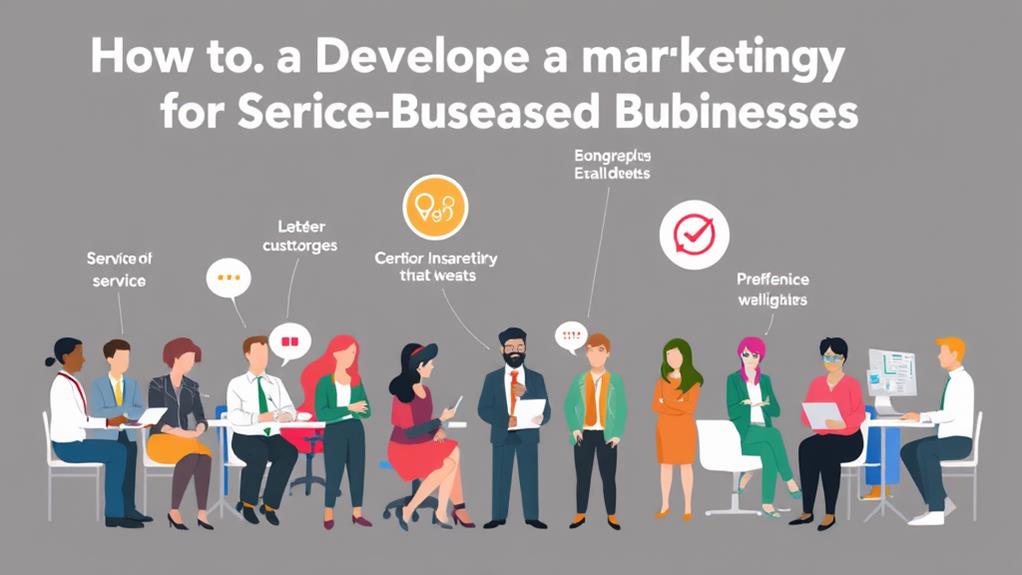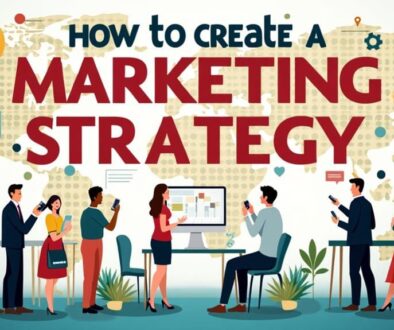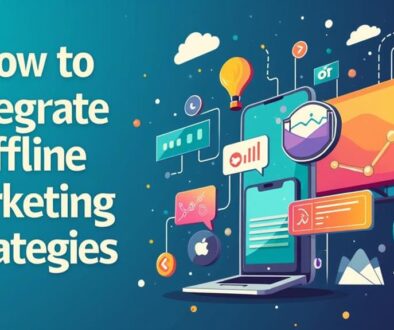How to Develop a Marketing Strategy for Service-Based Businesses
To develop an effective marketing strategy for service-based businesses, first define your target audience using demographic and psychographic insights. Conduct thorough market research to identify trends and gaps that can set you apart. Establish clear, measurable objectives to guide your efforts, ensuring accountability and progress. Analyze competitors to refine your unique value proposition while selecting appropriate marketing channels that enhance visibility and engagement. Craft a diverse content plan tailored to your audience's interests. Finally, implement a robust system for monitoring performance, allowing for adjustments that cater to evolving market demands. There's much more to explore in this strategic journey.
Key Takeaways
- Define your target audience using demographics and psychographics to create tailored messaging and customer personas.
- Conduct market research to identify trends, differentiate services, and better understand customer preferences.
- Establish clear, measurable objectives using the SMART framework to guide your marketing efforts effectively.
- Analyze competitors to refine your service offerings and develop unique selling propositions that resonate with customers.
- Monitor and adjust your marketing strategy regularly based on performance data and feedback to ensure continued relevance.
Define Your Target Audience

Understanding your target audience is paramount for the success of any service-based business. The foundation of your marketing strategy lies in clearly defining who your ideal customers are. By harnessing demographic insights—such as age, gender, income level, and geographic location—you can tailor your services to meet the specific needs and preferences of those you aim to serve. This allows your business to resonate more deeply, creating a bond of trust that liberates both consumers and providers.
Furthermore, developing customer personas enhances this understanding. Customer personas are semi-fictional representations of your target audience, incorporating not only demographics but also psychographics—values, interests, and pain points. By visualizing these personas, you create more than just data; you build narratives that guide your marketing efforts and shape your service offerings.
Imagine the freedom that comes from knowing precisely who you are working for. Gone are the days of casting a wide net and hoping for success. Instead, you can focus your resources, refine your messaging, and design tailored marketing campaigns that speak directly to the individuals who seek your services.
Each persona teaches you about your audience's desires, revolutionizing your approach and positioning your business as the solution they've been looking for. By defining your target audience through demographic insights and detailed customer personas, you empower both your business and its clients, planting the seeds for a flourishing partnership.
Conduct Market Research
To effectively carve out a niche in the competitive landscape of service-based businesses, conducting extensive market research is essential. Understanding customer demographics—age, income, location, and behavior—enables businesses to tailor their services to meet the distinct needs of their target market. This information not only helps identify potential clients but also informs marketing strategies that resonate deeply with them.
Equally important is analyzing industry trends, which can reveal opportunities for differentiation and innovation. By keeping a finger on the pulse of emerging technologies and evolving consumer preferences, businesses can adjust their offerings proactively rather than reactively. This strategic approach fosters adaptability and resilience in an ever-changing marketplace.
Moreover, engaging with existing customers through surveys, interviews, or social media can yield invaluable insights. These direct interactions not only reveal clients' pain points but also validate the effectiveness of current strategies. By leveraging this feedback, service-based businesses can cultivate stronger relationships, ensuring client loyalty and repeat business.
In the quest for freedom and business autonomy, market research emerges as a powerful tool. It empowers entrepreneurs to make informed decisions based on concrete data rather than assumptions.
Therefore, investing time and resources in extensive market research ultimately lays the groundwork for a robust marketing strategy—one that connects genuinely with the audience, anticipates needs, and seizes opportunities, paving the way for sustainable growth and success in the service industry.
Establish Clear Objectives

Establishing clear objectives is fundamental for guiding a service-based business's marketing efforts.
Identifying the target audience allows for tailored strategies that resonate with potential clients, while setting measurable goals guarantees accountability and progress tracking.
Define Target Audience
A service-based business's success hinges on a well-defined target audience, which serves as the cornerstone of an effective marketing strategy. To optimize outreach and engagement, businesses must engage in demographic profiling and audience segmentation. By analyzing variables such as age, income, location, and preferences, owners can create accurate portraits of their ideal clients, tailoring services that resonate deeply with their needs.
Understanding your target audience allows you to craft compelling messaging that connects on a personal level, fostering trust and loyalty. Audience segmentation further refines this approach, enabling the identification of specific groups within a larger market. This enables you to address unique pain points and aspirations, thereby creating an appealing value proposition.
Moreover, defining a target audience empowers businesses to allocate resources effectively. Rather than casting a wide net, focused strategies yield higher returns on investment.
Ultimately, knowing who you serve not only influences marketing tactics but also shapes service offerings. Businesses that take the time to understand and define their audience cultivate a loyal client base, paving the way for sustainable growth and unprecedented freedom in serving their clients' needs.
Set Measurable Goals
Setting measurable goals is essential for the long-term success of service-based businesses, as it transforms abstract aspirations into concrete targets. In creating a marketing strategy, utilizing the SMART framework—Specific, Measurable, Achievable, Relevant, Time-bound—ensures clarity and precision in your objectives. Rather than vaguely stating intentions to increase clientele, for instance, a SMART goal would specify a target of securing ten new clients within the next quarter.
Moreover, incorporating performance metrics is vital for tracking progress and refining strategies. Metrics such as lead conversion rates, customer retention rates, and average deal size provide concrete data points to evaluate effectiveness.
This data-driven approach not only fosters accountability but also encourages adaptive strategies that embrace freedom from rigid pathways and allow for innovative thinking.
Analyze Competitors Effectively
To enhance your service-based business strategy, a thorough competitor analysis is essential.
Begin by identifying key competitors within your market and evaluating their marketing tactics, as this will provide valuable insights into effective approaches and consumer engagement.
Identify Key Competitors
Identifying key competitors is an essential step in formulating an effective marketing strategy for service-based businesses. Conducting thorough competitor analysis allows you to understand the landscape in which you operate and the dynamics affecting market positioning. By identifying who your direct competitors are, you not only gauge their strengths and weaknesses but also uncover gaps in the market you could exploit to your advantage.
To effectively assess your competitors, consider their services, pricing structures, and customer engagement strategies. Evaluate their online presence, client feedback, and brand reputation to determine how they position themselves in the market. This insight equips you with the knowledge to refine your service offerings, differentiate your brand, and enhance customer experiences.
Furthermore, understanding competitor strategies informs your goal-setting, allowing you to formulate unique selling propositions that resonate with your target audience. Ultimately, this empowers you to create a marketing strategy that not only captures attention but retains customer loyalty amidst fierce competition.
Embrace this freedom of choice and forge a path that resonates with the values and needs of your clients while standing distinct in the marketplace.
Evaluate Marketing Tactics
Analyzing your competitors' marketing tactics is essential for shaping a strategy that stands out in a crowded service-based market. Start by evaluating their social media presence; understand which platforms they utilize and the engagement levels of their content. This insight allows you to identify gaps in your strategy, enabling you to connect more authentically with your target audience.
Next, scrutinize their email marketing campaigns, focusing on content, frequency, and overall effectiveness. Are they employing compelling subject lines and personalized messaging? Swiftly adapting these insights can enhance your outreach.
Additionally, consider their use of influencer partnerships. Are they aligning with credible figures to amplify their brand message? If so, think about how you might forge similar alliances.
Customer testimonials and referral programs are pivotal in building trust. Analyze how competitors leverage these, and consider creating a robust system that promotes organic growth through satisfied clients.
Investigate their local advertising efforts and SEO tactics as well; these elements contribute to their branding consistency. By thoroughly understanding these facets, you can innovate your approach and carve out a distinctive niche in the service-based landscape, paving your way to success.
Choose Marketing Channels

Selecting the right marketing channels is vital for service-based businesses seeking to optimize their outreach and enhance customer engagement. A well-rounded strategy that incorporates various platforms can help you connect authentically with your audience and cultivate long-lasting relationships.
Here are significant channels to take into account:
- Social Media: Utilize platforms like Facebook, Instagram, and LinkedIn to engage with potential and existing clients through compelling content and conversations.
- Email Marketing: Leverage targeted email campaigns to nurture leads and provide valuable insights, making certain that your customers feel informed and appreciated.
- Influencer Collaborations: Partner with local influencers whose audiences align with your service offerings, expanding your reach through authentic endorsements.
- Community Outreach: Engage directly with your local area by participating in events or sponsoring community initiatives, creating goodwill and visibility for your brand.
- Referral Programs: Encourage satisfied clients to refer others through incentives, fostering a strong word-of-mouth marketing strategy.
Other valuable channels might include paid advertising, which can amplify your brand presence quickly, and strategic SEO strategies to guarantee your website ranks well in search results.
Content syndication can boost your visibility on multiple platforms, while networking events offer unique opportunities for personal connections.
Develop Your Unique Value Proposition
Crafting a compelling Unique Value Proposition (UVP) is essential for service-based businesses aiming to differentiate themselves in a competitive market. A well-defined UVP succinctly articulates the unique benefits your service offers, influencing customer perception and positioning your brand as the go-to solution for specific needs.
It goes beyond mere features, focusing on how your services address pain points or desires that resonate deeply with your target audience.
To effectively develop your UVP, start by examining your differentiation strategies. Identify what sets your services apart from competitors—this may include superior quality, exceptional customer service, or innovative solutions.
Engaging with current and potential clients can reveal insights about their priorities and preferences, providing the foundation for a compelling UVP.
A successful UVP should be clear, concise, and emotionally appealing. It must create a shift in customer perception, where they see your service not just as an option but as the ideal choice to fulfill their needs.
Use persuasive language that speaks to their aspirations, underscoring how your offering empowers them and enhances their lives.
Create a Content Plan

A well-structured content plan serves as the backbone of any successful marketing strategy for service-based businesses. This plan not only aids in organizing thoughts but also paves the way for effective audience engagement. By strategically outlining content themes and formats, you create a roadmap that resonates with your target audience and builds lasting connections.
To develop an impactful content plan, consider the following elements:
- Content Themes: Identify overarching topics that align with your brand and audience interests.
- Content Formats: Diversify your offerings through blogs, videos, podcasts, infographics, and webinars to cater to various preferences.
- Seasonal Campaigns: Leverage holidays and events to create timely content, enhancing relevance and engagement.
- Storytelling Techniques: Craft compelling narratives that highlight your services and client success stories, making your content relatable and memorable.
- Distribution Strategies: Determine the most effective channels for sharing your content, whether it's social media, email newsletters, or your website.
Utilizing a content calendar guarantees consistency and aids in planning for SEO optimization, promoting visual content and interactive elements that capture attention.
Monitor and Adjust Your Strategy
Adaptability is a significant component of any successful marketing strategy for service-based businesses. In an ever-evolving marketplace where consumer preferences shift rapidly, the ability to monitor and adjust your strategy can mean the difference between stagnation and growth. This process begins with robust data analysis; by examining metrics such as client acquisition rates, engagement levels, and revenue per service, businesses can gain valuable insights into their performance.
Establishing strong feedback loops is essential for continuous improvement. These loops enable businesses to collect and interpret client feedback, allowing for timely adjustments to services and marketing approaches. Listening to your clients not only fosters loyalty but also highlights areas for enhancement, ensuring your offerings remain relevant and valuable.
Moreover, adapting your marketing strategy does not merely entail reacting to changes; it requires proactive planning. In a landscape characterized by innovation and disruption, regularly scheduled reviews of your strategy—incorporating both data analysis and client feedback—will empower your business to stay ahead of competitors.
By defining key performance indicators (KPIs), you can effectively track progress while anticipating market trends and consumer demands.
Ultimately, the freedom that comes from a flexible marketing strategy lies in the opportunities it creates. By committing to continuous monitoring and adjustment, service-based businesses can thrive, not just survive, thereby ensuring sustainable growth and enhanced customer satisfaction.
Frequently Asked Questions
What Are Common Mistakes in Service-Based Marketing Strategies?
Common mistakes in service-based marketing strategies often include failing to precisely identify the target audience and misaligning brand messaging with their needs.
When businesses overlook these critical elements, they risk alienating potential clients and diminishing brand credibility.
Additionally, neglecting the importance of consistent communication can lead to misunderstandings and lost opportunities.
To achieve effective marketing outcomes, it is essential to craft a strategy that resonates deeply with the intended audience and reflects the brand's core values.
How Do I Budget for My Marketing Efforts?
Budgeting for marketing efforts requires a strategic approach that begins with conducting a thorough cost analysis.
Identify key expenses, including digital advertising, content creation, and promotional events. Allocate resources based on expected returns while remaining mindful of market trends.
By establishing a flexible marketing budget, you enhance your capacity to adapt to changing circumstances, fostering innovation and creativity in your campaigns.
Ultimately, an effective budget empowers your business to pursue opportunities for growth with confidence.
How Long Does It Take to See Results?
Research indicates that 70% of businesses expect to see marketing results within three to six months, highlighting varied timeframe expectations across different sectors.
To effectively gauge success, it is crucial to establish clear KPIs aligned with your objectives. While some initiatives may yield immediate effects, others require sustained effort for meaningful impact.
Adapting strategies based on ongoing analysis guarantees that your marketing approach evolves, ultimately enhancing the likelihood of achieving desired outcomes.
Should I Use Paid Advertising for My Service?
Utilizing paid advertising for your service can considerably amplify your outreach and visibility within your target audience.
By strategically selecting ad platforms that align with where your potential clients congregate, you create opportunities for engagement and conversion.
This method not only enhances brand recognition but also facilitates precise targeting, ultimately leading to improved results.
Investing in paid advertising can provide a substantial advantage in a competitive landscape, fostering a sense of freedom to innovate your marketing approach.
How Often Should I Update My Marketing Strategy?
Frequency fosters effective marketing; therefore, a consistent frequency assessment is essential.
Regularly updating your marketing strategy—ideally every quarter—ensures it remains relevant and responsive to market shifts.
Conduct an extensive strategy evaluation to identify strengths, weaknesses, and opportunities for growth.
Conclusion
In the intricate dance of service-based business marketing, one must navigate a labyrinth of strategies and consumer whims, armed solely with spreadsheets and unquenchable caffeine. A thorough marketing strategy not only delineates the target audience but also transforms market research into a crystal ball for predicting trends. By embracing the paradox of constant evaluation and adjustment, businesses can expertly pivot and outwit competitors, ultimately demonstrating that effective marketing is indeed the art of choreographed chaos in an unpredictable world.




